Honor Award
Water + Nature: Sustainable Growth Renewing Neighborhoods
Ashlee Grubbs, Student ASLA and William Gunn, Student ASLA, Graduate, Arizona State University
Faculty Advisors: Catherine Spellman and Gabriel
Diaz-Montemayor, ASLA
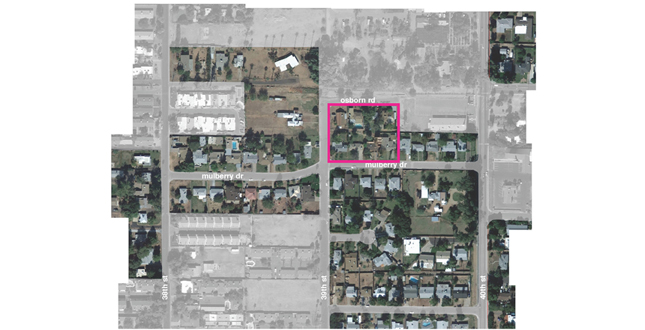 Close Me!
Close Me!The future growth in Phoenix must happen in the middle by investing more in our existing communities to minimize sprawl. Better management of resources on the single family lot, a predominant landscape typology, could result in a more sustainable city.
Download Hi-Res ImageImage: Ashlee Grubbs and William Gunn
Image 1 of 15
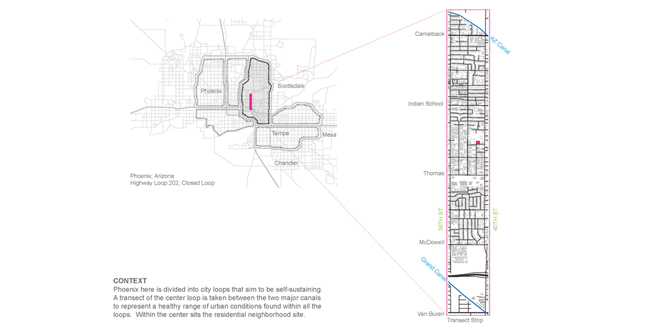 Close Me!
Close Me!Context — Phoenix here is divided into city loops that aim to be self-sustaining. A transect of the center loop is taken between the two major canals to represent a healthy range of urban conditions found within all the loops. Within the center sits the residential neighborhood site.
Download Hi-Res ImageImage: Ashlee Grubbs and William Gunn
Image 2 of 15
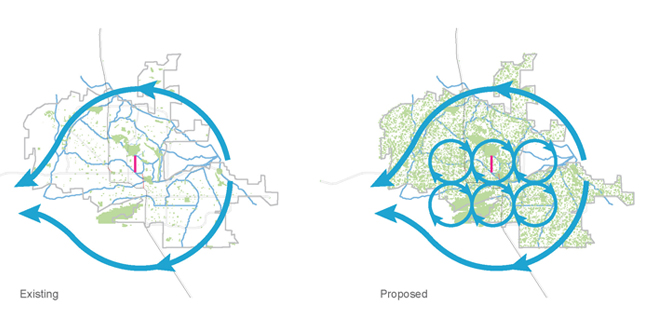 Close Me!
Close Me!Water + Nature Closed Loop — For Phoenix to become more sustainable, water must be managed in neighborhoods by means of diversion, filtration, retention and reuse. Water should be contained in multiple closed loop systems across the city to be used in harmony with its other various functions and demands.
Download Hi-Res ImageImage: Ashlee Grubbs and William Gunn
Image 3 of 15
 Close Me!
Close Me!By 2025, 1/3 of all humans will face severe and chronic water shortages due to lack of access to freshwater.
Download Hi-Res ImageImage: Ashlee Grubbs and William Gunn
Image 4 of 15

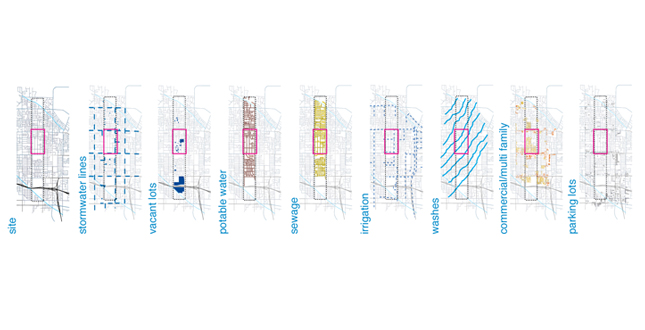 Close Me!
Close Me!Existing Systems — Mappings of the existing conditions and multiple systems across the site transect reveal the potential for water and nature within the city.
Download Hi-Res ImageImage: Ashlee Grubbs and William Gunn
Image 6 of 15
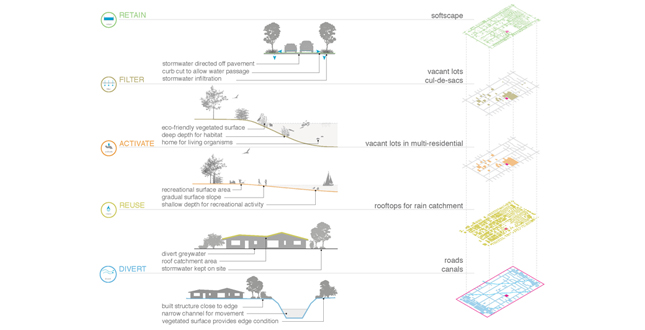 Close Me!
Close Me!Urban Water Strategies — the potential for utilizing water across the neighborhood.
Download Hi-Res ImageImage: Ashlee Grubbs and William Gunn
Image 7 of 15
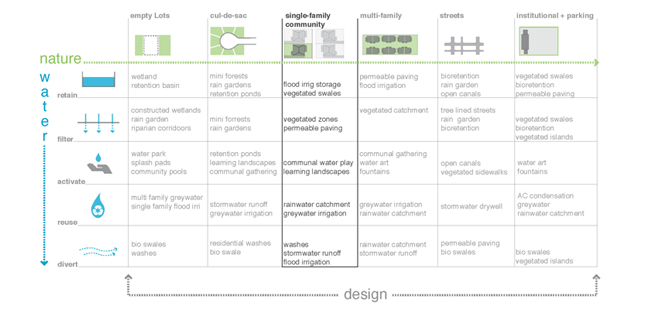 Close Me!
Close Me!Urban Water + Nature Matrix — A pattern book approach to the design of the different water strategies in accordance with six common landscape typologies, of which can be found in every neighborhood within the Phoenix metropolitan area.
Download Hi-Res ImageImage: Ashlee Grubbs and William Gunn
Image 8 of 15
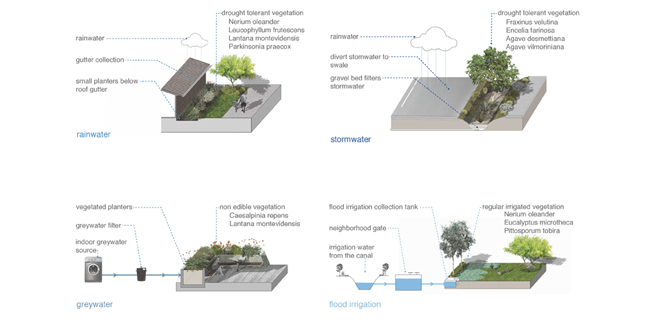 Close Me!
Close Me!Water Sources and Applications — There are potentially 4 alternative water sources to potable that can be used to irrigate the residential landscape: rainwater, stormwater, greywater, and flood irrigation. Each water type is collected, diverted and applied differently.
Download Hi-Res ImageImage: Ashlee Grubbs and William Gunn
Image 9 of 15
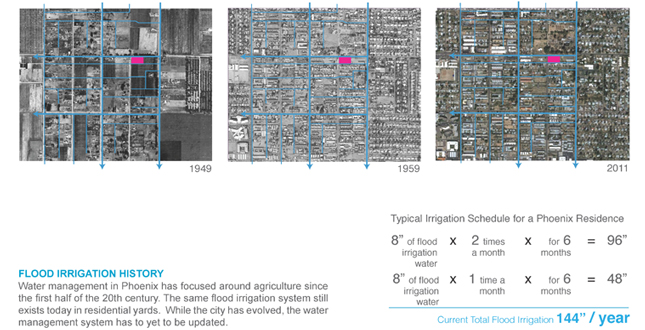 Close Me!
Close Me!Flood Irrigation History — Water management in Phoenix has focused around agriculture since the first half of the 20th century. The same flood irrigation system still exists today in residential yards. While the city has evolved, the water management system has to yet to be updated.
Download Hi-Res ImageImage: Ashlee Grubbs and William Gunn
Image 10 of 15
 Close Me!
Close Me!Single Family Existing Water Use — Currently the main water sources for single-family residential neighborhoods consist of potable water and flood irrigation, used lot by lot individually. Stormwater is expeditiously diverted to the Salt River. Neither greywater nor rainwater are harvested on site.
Download Hi-Res ImageImage: Ashlee Grubbs and William Gunn
Image 11 of 15
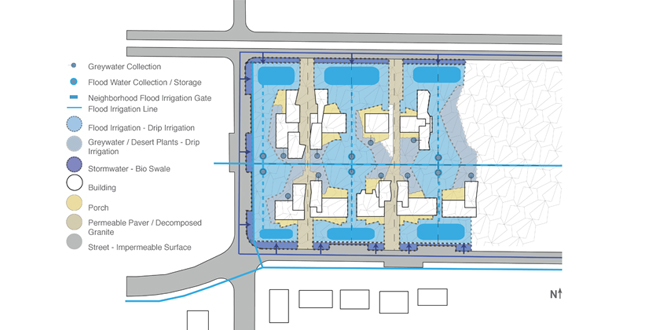 Close Me!
Close Me!Single Family Proposed Water Use — Proposed is a significant reduction in flood irrigation by utilizing it across communal yard spaces rather than individual yards. Micro canals collect and retain stormwater. Greywater is collected and used for desert appropriate vegetation near the dwellings.
Download Hi-Res ImageImage: Ashlee Grubbs and William Gunn
Image 12 of 15
 Close Me!
Close Me!Single Family Proposed Nature — While the amount of water used on the site has decreased, it is possible to increase the shade canopy and create more comfortable spaces. By more creatively managing water, more nature can exist in the residential communities.
Download Hi-Res ImageImage: Ashlee Grubbs and William Gunn
Image 13 of 15
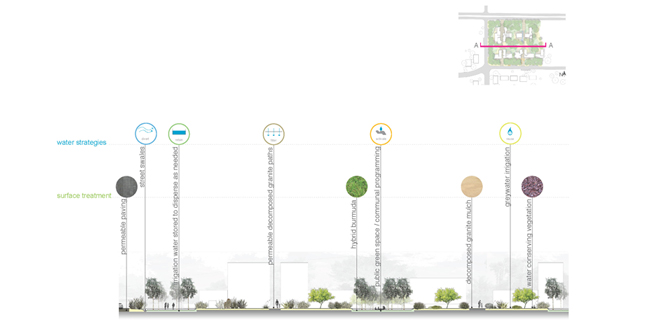 Close Me!
Close Me!Water + Nature Proposed Section
Download Hi-Res ImageImage: Ashlee Grubbs and William Gunn
Image 14 of 15
 Close Me!
Close Me!Existing: Single story ranch houses cause growth to spread out rather than up. Excessive flood irrigation in individual yard. Insufficient shade increases cooling costs. Lack of variety in ground surfaces. Alley walls limit yard space and prohibit community interaction. Proposed: Group plants with similar water needs. Trees produce shade for cool comfortable spaces. Mulches reduce evaporative moisture loss. Composting garden waste and reusing organic matter. Residential towers to double the density. Communal outdoor space.
Download Hi-Res ImageImage: Ashlee Grubbs and William Gunn
Image 15 of 15
Project Statement
Water management and a progressive nature infrastructure system are essential to the making of a sustainable urban environment. With current technologies cities can greatly decrease water use while simultaneously increasing nature in urban environments. Having the effect of creating healthier, cooler and more livable cities.
Project Narrative
—2011 Student Awards Jury
Cities are often ranked by their level of livability and sustainability; two closely related indicators that broadly take into account economic, social, and environmental factors. Consistently Phoenix has scored low under these indicators. In Phoenix, this fact is currently exacerbated by the housing and financial crisis, the rising costs of energy and gas, the continual increase of urban temperatures, the depletion of municipal resources by continuingly extending infrastructure, and the continued loss of neighborhood identity through repetition and dispersal; all of which suggest that the current pattern of growth is not sustainable.
For a desert city like Phoenix, water is an important and rare resource. As the city experiences an increase in population and density, water will become even more valuable. It’s predicted that by 2025, 1/3 of all humans will face severe & chronic water shortages. Climate change will further impact water supplies by increasing pressures on water resources caused by population and economic growth. With 1.6 million residences, Phoenix is the fifth largest city in the United States and is anticipated to double by 2025. However, it only receives 8.3 inches of rain a year, which does not begin to serve its need. Most of the water is transported into the city over hundreds of miles through canals and high energy using pumps. The Central Arizona General Replenishment District projects the district will not be able to meet its replenishment obligation by 2020 and possibly as early as 2015. How do we limit water use to better meet current and anticipated needs? Where will the sources of water come from?
The absence of a nature infrastructure system in Phoenix adds to the water problem by not maintaining permeable surfaces for water to seep through and replenish the aquifers. Additionally, the excessive impermeable surfaces creating an exceedingly hot environment with diminished air quality. A nature infrastructure would have the potential to improve air quality, create shade, decrease surface temperatures, and improve the quality of the cities outdoor spaces. Today people move to the cities edge in part to be closer to nature. By bringing more nature to central Phoenix, residents may opt to further invest in their current neighborhoods for more sustainable communities and comfortable urban spaces.
The fact is that there are already alternative sources to potable water that exist within these neighborhoods: rainwater, flood irrigation, greywater, and stormwater. Each of these water types could be reconsidered and better managed across the Phoenix valley to create more comfortable, cooler spaces within residential communities. Water in our study becomes the dominant ordering system for neighborhoods, informing the creation of outdoor environments. In particular, it determines the configuration of regionally appropriate vegetation and the use of permeable pavers. There are four sustainable water management systems that Phoenix can employ (diversion, filtration, retention, and reuse) to make better use of the water types available (rain water, flood irrigation, grey water and black water). By studying both water management systems and water types we are able to make a matrix that describes the potential of paring management systems with water types. Currently only treated water that enters the city through the flood irrigation canal system is managed within the city.
Flood irrigation is a process of moving water hundreds of miles across the state with high-energy using pumps and canals in order to irrigate agriculture and later treat for drinking water. With population growth, agriculture was phased out as suburban residential growth increased and the water rights were transferred from agriculture to municipal. While the Phoenix landscape and its needs have significantly changed in the last decades, the flood irrigation method used for agriculture remains the same. While that system was sufficient for its time, it is now a wasteful means of delivering water to individual residential lots to irrigate yards and to treatment centers for potable water. For example, the typically flood irrigated lawn in Phoenix receives about 144" a year in water. However, the current lawns and vegetated areas that use this flood irrigation really only need 42" / year and by reducing the amount of lawn and using arid tolerant vegetation, this need can also be diminished.
The average household uses 60% of its total water use outdoors and %40 indoors. All of the water indoors is currently treated as black water and discharged into sewage, yet much of that water (25% of the 40% used indoors) can be reused as grey water when properly collected from laundry, dishwater, showers, and faucets. By reusing grey water the average household could drop the use of potable water within a day from 100 gallons a day to only 30.
The miles of concrete in the Phoenix urban environment prohibit stormwater from properly percolating into the soil. Phoenix only receives 7.6" of rainwater per year and only 2 out of every 10 drops reach the soil to recharge the aquifer. Most water on the site hits impermeable pavement before being carried off site to be disposed of in the Salt River. We can potentially do more with less water by reusing it across residential plots before it’s lost to sewage lines and directed to the salt. By reusing our water we are essentially more water that can be used for the encouragement of more nature and cooler outdoor spaces.
Each yard, home, street and parking lot has the potential to do more for the environment and us. Each landscape typology seen across the valley can be rethought to better move and manage water for a more comfortable, dynamic, and sustainable city. The water strategies used in Phoenix neighborhoods should reflect the conditions of the given context. The landscape should be an expression of this condition, while comfortably accommodating a denser city fabric. This becomes an invaluable asset to any Phoenix community by creating more comfortable outdoor spaces, increasing property values, and adding needed character to the homogeny of the current suburban sprawl condition.
Additional Project Credits
Advisors
Kim Steele; Joe Ewan, ASLA ; Heather Kinkade, ASLA; Angel Trevino
Water Research: The US Agency for International Development
Larson, E.K. The paradoxical ecology and management of water in the Phoenix, USA Metropolitan area.






